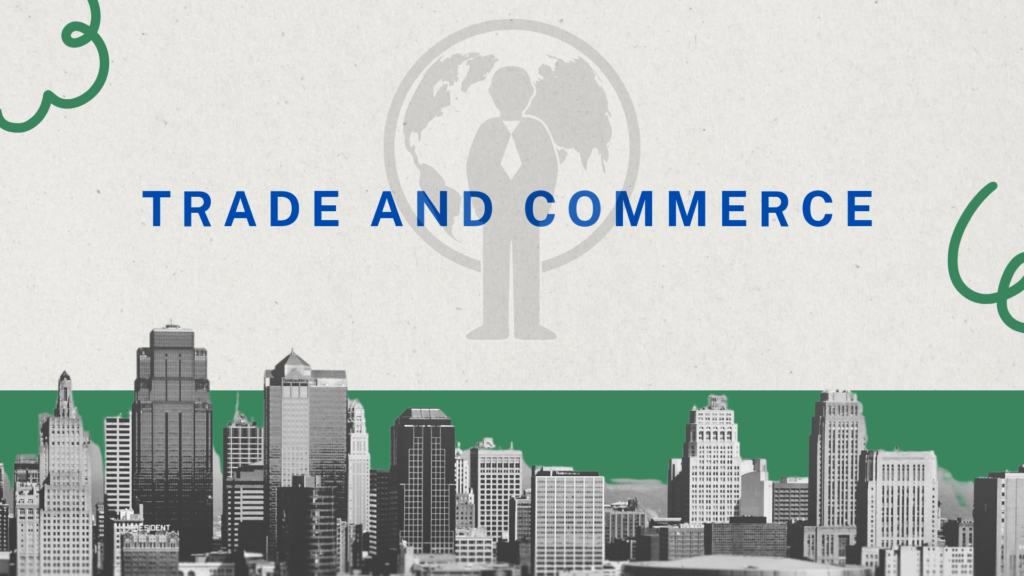Trade and Commerce: The Cornerstones of Global Prosperity
Trade and commerce have been fundamental to the development of civilizations throughout history, serving as the engines of economic growth, fostering cultural exchange, and promoting global interconnectedness. In this article, we will explore the key concepts of trade and commerce, their historical significance, and their role in the modern global economy. Introduction Trade refers to the exchange of goods and services between individuals, businesses, or nations. It has been a part of human society for millennia and has evolved significantly over time. Commerce, on the other hand, encompasses a broader spectrum of economic activities, including not only trade but also financial transactions, services, and the facilitation of business operations. Historical Significance: Trade and commerce have played pivotal roles in shaping the course of history. From the ancient Silk Road, connecting East and West, to the maritime trade routes that expanded during the Age of Exploration, commerce has facilitated the exchange of ideas, cultures, and resources. Trade often led to the diffusion of technologies, religions, and goods, enriching societies and sparking innovation . The Age of Exploration in the 15th and 16th centuries further expanded global trade. European explorers like Christopher Columbus and Vasco da Gama opened up new trade routes, leading to the Columbian Exchange, an era of global trade that brought previously unknown goods like potatoes, tomatoes, and tobacco to the Old World.. Key Components of Trade and Commerce: 1. International Trade: In the modern era, countries engage in international trade to obtain resources and products not readily available domestically. This exchange benefits nations by stimulating economic growth and enhancing consumer choices. 2. E-commerce: The rise of the internet has revolutionized commerce, enabling online shopping, digital payment systems, and global marketplaces. E-commerce has made it possible for businesses of all sizes to reach a global customer base. Supply Chain Management: Efficient logistics and supply chain management are crucial aspects of commerce, ensuring that products reach consumers in a timely and cost-effective manner. 4. Financial Services: Banking and financial institutions play a vital role in commerce by providing the infrastructure for transactions, investments, and credit, facilitating economic activities. Trade and the Modern Global Economy: In the 21st century, trade and commerce have become integral to the global economy. Some key aspects include: 1. Globalization: The increasing interconnectedness of economies has accelerated due to trade agreements, technology, and transportation advancements. This has both benefits, such as access to a wider range of products, and challenges, like job displacement in certain industries. 2. Economic Growth: Trade contributes to economic growth by promoting specialization and efficiency. Nations can focus on producing goods and services in which they have a comparative advantage, leading to increased productivity. 3. Challenges and Controversies: Trade disputes, tariffs, and concerns about labor and environmental standards are persistent challenges. Striking a balance between open markets and fair practices is an ongoing debate. 4. Digital Economy: The digital revolution has transformed commerce by enabling the trade of intangible goods and services, such as software, entertainment, and information. 5. Poverty Reduction: Trade can alleviate poverty by providing opportunities for income generation, especially in developing countries. By exporting goods and services, these nations can access global markets, generate revenue, and improve the well-being of their populations. 6. Cultural Exchange: Trade has always been a vehicle for cultural exchange. The exchange of goods and ideas between nations fosters cultural understanding and enriches societies. Cuisine, art, music, and language often cross borders through trade. Challenges and Concerns While trade and commerce bring numerous benefits, they also pose challenges and concerns. Issues like income inequality, environmental degradation, and job displacement have been associated with globalization. It is crucial for policymakers to address these challenges to ensure that the benefits of trade are shared equitably. Conclusion: Trade and commerce are the lifeblood of the global economy. They have been instrumental in historical developments, cultural exchange, and economic growth. In the contemporary world, these concepts continue to evolve, driven by technology and interconnectedness. While they offer immense opportunities, they also present challenges that require careful management and international cooperation. In essence, trade and commerce remain the cornerstones of prosperity and progress in our interconnected world.




